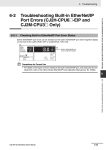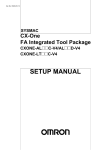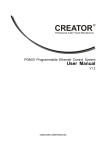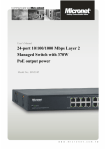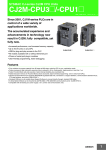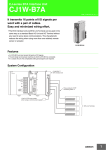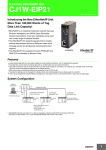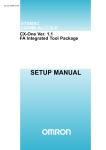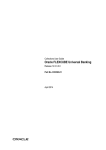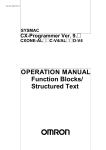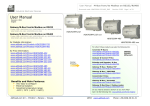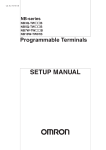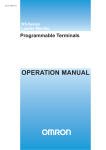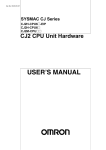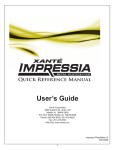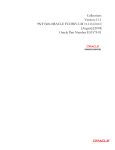Download R157-E1-02 - Products
Transcript
EtherNet/IP Monitor Tool Operation Manual Introduction This manual documents the operating procedures of the EtherNet/IP Monitor Tool. It does not contain other information, such as precautions. In actual use, obtain the operation manuals of the relevant CPU Units, EtherNet/IP Units, and Support Software, read the required application information, including all precautions, and adequately check operation before you use the EtherNet/IP Monitor Tool. Trademarks • EtherNet/IP is a registered trademark of the ODVA (Open DeviceNet Vendor Association). • Windows, Windows XP, Windows Vista, and Windows 7 are registered trademarks of Microsoft Corporation in the USA and other countries. • Other company names and product names in this document are the trademarks or registered trademarks of their respective companies. Ethernet/IP Monitor Tool Operation Manual (R157) Ethernet/IP Monitor Tool Operation Manual (R157) Table of Contents Table of Contents ............................................................................................. 1 Read and Understand this Manual.................................................................. 2 Related Manuals ............................................................................................... 5 1 The EtherNet/IP Monitor Tool .................................................................... 6 2 Function Specifications........................................................................... 10 2.1 Main Window............................................................................................................. 10 2.2 Menu Commands ...................................................................................................... 11 2.3 Toolbar....................................................................................................................... 11 2.4 Main Tab Page........................................................................................................... 12 2.4.1 Setting the Configuration Device ........................................................................ 13 2.4.2 Network Status Area ........................................................................................... 14 2.4.3 Connection Status Area ...................................................................................... 15 2.4.4 SYSMAC Gateway Service................................................................................. 16 2.4.5 Device Information Area...................................................................................... 16 2.5 Setting Tab Page ....................................................................................................... 17 2.5.1 Basic Tab Page ................................................................................................... 18 2.5.2 Producer Tab Page ............................................................................................. 25 2.5.3 Consumer Tab Page ........................................................................................... 27 2.5.4 Message Tab Page ............................................................................................. 29 2.5.5 User Define Tab Page ......................................................................................... 31 2.6 Monitoring Tab Page.................................................................................................. 36 2.6.1 Producer Tab Page ............................................................................................. 37 2.6.2 Consumer Tab Page ........................................................................................... 39 2.6.3 Message Tab Page ............................................................................................. 41 2.6.4 Connection Tab Page.......................................................................................... 43 2.6.5 Data Log Tab ...................................................................................................... 46 Ethernet/IP Monitor Tool Operation Manual (R157) 1 Read and Understand this Manual Please read and understand this manual before using the product. Please consult your OMRON representative if you have any questions or comments. Warranty and Limitations of Liability WARRANTY OMRON's exclusive warranty is that the products are free from defects in materials and workmanship for a period of one year (or other period if specified) from date of sale by OMRON. OMRON MAKES NO WARRANTY OR REPRESENTATION, EXPRESS OR IMPLIED, REGARDING NONINFRINGEMENT, MERCHANTABILITY, OR FITNESS FOR PARTICULAR PURPOSE OF THE PRODUCTS. ANY BUYER OR USER ACKNOWLEDGES THAT THE BUYER OR USER ALONE HAS DETERMINED THAT THE PRODUCTS WILL SUITABLY MEET THE REQUIREMENTS OF THEIR INTENDED USE. OMRON DISCLAIMS ALL OTHER WARRANTIES, EXPRESS OR IMPLIED. LIMITATIONS OF LIABILITY OMRON SHALL NOT BE RESPONSIBLE FOR SPECIAL, INDIRECT, OR CONSEQUENTIAL DAMAGES, LOSS OF PROFITS OR COMMERCIAL LOSS IN ANY WAY CONNECTED WITH THE PRODUCTS, WHETHER SUCH CLAIM IS BASED ON CONTRACT, WARRANTY, NEGLIGENCE, OR STRICT LIABILITY. In no event shall the responsibility of OMRON for any act exceed the individual price of the product on which liability is asserted. IN NO EVENT SHALL OMRON BE RESPONSIBLE FOR WARRANTY, REPAIR, OR OTHER CLAIMS REGARDING THE PRODUCTS UNLESS OMRON'S ANALYSIS CONFIRMS THAT THE PRODUCTS WERE PROPERLY HANDLED, STORED, INSTALLED, AND MAINTAINED AND NOT SUBJECT TO CONTAMINATION, ABUSE, MISUSE, OR INAPPROPRIATE MODIFICATION OR REPAIR. 2 Ethernet/IP Monitor Tool Operation Manual (R157) Application Considerations SUITABILITY FOR USE OMRON shall not be responsible for conformity with any standards, codes, or regulations that apply to the combination of products in the customer's application or use of the products. At the customer's request, OMRON will provide applicable third party certification documents identifying ratings and limitations of use that apply to the products. This information by itself is not sufficient for a complete determination of the suitability of the products in combination with the end product, machine, system, or other application or use. The following are some examples of applications for which particular attention must be given. This is not intended to be an exhaustive list of all possible uses of the products, nor is it intended to imply that the uses listed may be suitable for the products: • Outdoor use, uses involving potential chemical contamination or electrical interference, or conditions or uses not described in this manual. • Nuclear energy control systems, combustion systems, railroad systems, aviation systems, medical equipment, amusement machines, vehicles, safety equipment, and installations subject to separate industry or government regulations. • Systems, machines, and equipment that could present a risk to life or property. Please know and observe all prohibitions of use applicable to the products. NEVER USE THE PRODUCTS FOR AN APPLICATION INVOLVING SERIOUS RISK TO LIFE OR PROPERTY WITHOUT ENSURING THAT THE SYSTEM AS A WHOLE HAS BEEN DESIGNED TO ADDRESS THE RISKS, AND THAT THE OMRON PRODUCTS ARE PROPERLY RATED AND INSTALLED FOR THE INTENDED USE WITHIN THE OVERALL EQUIPMENT OR SYSTEM. PROGRAMMABLE PRODUCTS OMRON shall not be responsible for the user's programming of a programmable product, or any consequence thereof. Ethernet/IP Monitor Tool Operation Manual (R157) 3 Disclaimers CHANGE IN SPECIFICATIONS Product specifications and accessories may be changed at any time based on improvements and other reasons. It is our practice to change model numbers when published ratings or features are changed, or when significant construction changes are made. However, some specifications of the products may be changed without any notice. When in doubt, special model numbers may be assigned to fix or establish key specifications for your application on your request. Please consult with your OMRON representative at any time to confirm actual specifications of purchased products. DIMENSIONS AND WEIGHTS Dimensions and weights are nominal and are not to be used for manufacturing purposes, even when tolerances are shown. PERFORMANCE DATA Performance data given in this manual is provided as a guide for the user in determining suitability and does not constitute a warranty. It may represent the result of OMRON's test conditions, and the users must correlate it to actual application requirements. Actual performance is subject to the OMRON Warranty and Limitations of Liability. ERRORS AND OMISSIONS The information in this manual has been carefully checked and is believed to be accurate; however, no responsibility is assumed for clerical, typographical, or proofreading errors, or omissions. 4 Ethernet/IP Monitor Tool Operation Manual (R157) Related Manuals • CPU Units Man. No. W472 Model numbers CJ2H-CPU6 -EIP Manual name SYSMAC CJ Series CJ2 CPU Unit Hardware USER’S MANUAL CJ2H-CPU6 CJ2M-CPU W473 CJ2H-CPU6 -EIP SYSMAC CJ Series CJ2 CPU Unit Software USER’S MANUAL CJ2H-CPU6 CJ2M-CPU W394 CS1 -CPU - SYSMAC CS Series, SYSMAC CJ Series, and SYSMAC One NSJ CJ2H-CPU6 -EIP Series Programmable Controllers INSTRUCTIONS REFERENCE CJ2H-CPU6 MANUAL CJ2M-CPU CJ1 -CPU NSJ W474 - - CS1 -CPU - CJ2H-CPU6 -EIP SYSMAC CS Series, SYSMAC CJ Series, and SYSMAC One NSJ Series Programmable Controllers PROGRAMMING MANUAL CJ2H-CPU6 CJ2M-CPU CJ1 -CPU NSJ W342 - - CS1G/CS1H/CS1D/CS1W SYSMAC CS/CJ/CP Series and SYSMAC One NSJ Series CJ2H/CJ2M Communications Commands REFERENCE MANUAL CJ1G/CJ1H/CJ1M/CJ1W CP1H/CP1L/CP1E/ NSJ • Communications Units W465 CS1W-EIP21 SYSMAC CS and CJ Series EtherNet/IP Units Communications CJ1W-EIP21 Commands REFERENCE MANUAL CJ2H-CPU6 -EIP CJ2M-CPU3 • Support Software Man. No. Model numbers Manual name W463 CXONE-AL C-V4 CX-One FA Integrated Tool Package SETUP MANUAL W446 CXONE-AL D-V4 CX-Programmer Ver. 9. OPERATION MANUAL CX-Programmer Ver. 9. OPERATION MANUAL Function W447 Blocks/Structured Text W469 CX-Programmer Ver. 9. W366 CX-Simulator Ver. 1.9 OPERATION MANUAL W464 CX-Integrator Ver. 2. W344 CX-Protocol Ver. 1.9 OPERATION MANUAL W433 CX-Position Ver. 2.5 OPERATION MANUAL W436 CX-Motion-NCF Ver. 1.9 OPERATION MANUAL W448 CX-Motion-MCH OPERATION MANUAL Ethernet/IP Monitor Tool Operation Manual (R157) Operation Manual SFC Programming OPERATION MANUAL 5 1 The EtherNet/IP Monitor Tool • The EtherNet/IP Monitor Tool The EtherNet/IP Monitor Tool is a software application for monitoring the communications status of CS/CJ-series EtherNet/IP Units and SYSMAC Gateway EtherNet/IP and for setting connections for tag data links. If the configuration device is a SYSMAC Gateway, you can specify local devices on the same computer or remote devices on other computers. The system configuration supported by the EtherNet/IP Monitor Tool is shown below. These devices can be set and monitored. EtherNet/IP Monitor Tool EtherNet/IP Monitor Tool SYSMAC Gateway These devices can be set and monitored. These devices can be set and monitored. EtherNet/IP SYSMAC Gateway Cx1W-EIP21 CJ2x-EIP21 Network devices 6 Ethernet/IP Monitor Tool Operation Manual (R157) • EtherNet/IP Monitor Tool Functions The functions of the EtherNet/IP Monitor Tool are listed below. Monitoring Setting Function Details Network status display You can display the IP address, CIP port number, and the operating status of the configuration device. Connection status display You can display the tag type (Producer, Consumer, UCMM, or Class 3), the total number of connections, and the communications status of the connections. Tag status display You can display the communications status and data of producer and consumer tags. You can display detailed information, such as the total number of connections, the connection time, and the time not connected. Data logging You can set the trigger conditions and log tag data. Logged data is saved to a file. (This function is supported only for SYSMAC Gateway.) Tag and connection settings You can set producer tags, consumer tags, and message tags. (Message tags are enabled only for SYSMAC Gateway.) Ethernet/IP Monitor Tool Operation Manual (R157) 7 • Supported Models Model Name Remarks CJ2H built-in EtherNet/IP port (*1) CJ1W-EIP21 CJ-series EtherNet/IP Unit (*1) CS1W-EIP21 CS-series EtherNet/IP Unit (*1) WS02-SGWC1 SYSMAC Gateway (*2) CJ2H-CPU -EIP (*1) Unit version 2.1 or later is required. (*2) Software version 1.3 or higher is required. • System Requirements Item Operating system (Japanese or English) Computer Memory Hard disk Display Disk drive Communications port 8 System requirement Microsoft Windows XP (Service Pack 3 or higher, 32-bit edition) Microsoft Windows Vista Microsoft Windows 7 A personal computer with the processor that is recommended by Microsoft Corporation The memory capacity that is recommended by Microsoft Corporation Approx. 20 MB or more of available hard disk space is required. XGA (1,024 x 768), High Color, 16-bit or higher CD-ROM or DVD-ROM drive Ethernet port Ethernet/IP Monitor Tool Operation Manual (R157) • Installation Procedure Execute the EtherNet/IP Monitor Tool setup program and install the software according to the instructions that are displayed. There are setup programs available for both English and Japanese. Select the setup program for the language to use. By default, the EtherNet/IP Monitor Tool is installed in the following directory: C:\Program Files\OMRON\EtherNetIP Monitor Tool. OMRON EtherNetIP Monitor Tool is also registered on the Windows Start Menu. • Uninstallation Procedure Select and delete the EtherNet/IP Monitor Tool from Add or Remove Programs or Programs and Features in the Control Panel. Ethernet/IP Monitor Tool Operation Manual (R157) 9 2 Function Specifications 2.1 Main Window The Main Window of the EtherNet/IP Monitor Tool is shown below. The Main Window is made up of the three following main tab pages. 10 Tab label Description Main This tab page displays tables of the active status and connection status of the devices (NICs) that are set on the Setting Tab Page. It is also used to start and stop communications services for devices that are local SYSMAC Gateways. Setting This tab page is used to register EtherNet/IP connections and produce/consume tags. Monitoring This tab page is used to monitor the connection status of produce and consume tags. Ethernet/IP Monitor Tool Operation Manual (R157) 2.2 Menu Commands You can execute the following functions with the menu commands. Menu command Function File − New Creates a project. File − Open Opens an existing project. File − Save Saves the project. File − Save As Saves the project under a specified name. You can select to save either an EtherNet/IP Monitor Tool project file or a device configuration file (*.dvf) for use with the Network Configurator. File − Connect Connects to the configuration device if it is a remote device. File − Disconnect Disconnects from the configuration device. File − Exit Exits the EtherNet/IP Monitor Tool. View − Toolbar Shows or hides the toolbar. View − Status bar Shows or hides the status bar. Help − Version Information Displays the EtherNet/IP Monitor Tool's version information. 2.3 Toolbar You can execute the following functions from the toolbar. Toolbar icon Function Creates a project. Opens an existing project. Saves the project. Connects to the configuration device if it is a remote device. Disconnects from the configuration device. Displays the EtherNet/IP Monitor Tool’s version information. Ethernet/IP Monitor Tool Operation Manual (R157) 11 2.4 Main Tab Page The Main Tab Page is shown below. The following operations can be performed from the Main Tab Page. 12 Item Function Configuration Device Select the configuration device to set and monitor. You can select any of the devices that are given in the supported model list. For SYSMAC Gateway, you can select either local or remote devices. Network Status This area is used to monitor and display the status of devices that are registered on the Setting Tab Page. Connection Status This area is used to monitor and display the status of tags that are registered on the Setting Tab Page. SYSMAC Gateway Service This area is used to start and stop the communications services if the configuration device is a local SYSMAC Gateway device. Device Information This area displays information on the configuration device. Ethernet/IP Monitor Tool Operation Manual (R157) 2.4.1 Setting the Configuration Device The Configuration Device Box is used to select the device to set and monitor with the EtherNet/IP Monitor Tool. You can select any of the devices that are given in the supported model list. For SYSMAC Gateway, you can select either local or remote devices. The default is the device that was previously selected. If a device was not previously selected, the default is Local: SYSMAC Gateway. If the SYSMAC Gateway is not installed on the computer that is being used for operation, Local: SYSMAC Gateway is not displayed. The device information is displayed in the Device Information Area for the selected device. If Remove Device is selected as the configuration device, the Connect Button in the toolbar is enabled. The connection is made to the configuration device from the following dialog box. If the selected device does not match the setting in the Configuration Device Box, the following error message is displayed and the connection is not made: The Specified device type is not same as the current configuration device type. If the Disconnect Button is clicked, monitoring is stopped and the device is disconnected. Ethernet/IP Monitor Tool Operation Manual (R157) 13 2.4.2 Network Status Area The following information is displayed in the Network Status Area. Item Details Local This column displays the local and remote port names that are set on the Setting Tab Page. If the configuration device is set to Remote Devices, the local port names are not displayed. Only the remote port names are displayed. IP Address This column displays the port names that are assigned to the address names. CIP Port The CIP port numbers of the port names are displayed only if the configuration device is set to Local: SYSMAC Gateway. Status This column displays whether the active status of the device is OK. The open/closed status of the ports are displayed if the configuration device is set to Local: SYSMAC Gateway. The status can also be identified using the icon that is displayed beside the port name. The icon and status displays change with the device status as shown in the following table. Icon Status display Status --- • Local Port Local: SYSMAC Gateway: Servicing is stopped. • Remote Port There is no corresponding status. OK • Local Port Local: SYSMAC Gateway: The port is open. • Remote Port There is a device at the IP address. NG • Local Port Local: SYSMAC Gateway: The port is closed. • Remote Port There is no device at the IP address. To confirm whether a device is at the IP address, PING is used to send and receive an ICMP packet. ICMP packets are consecutively sent to all IP addresses. The ICMP packet response monitoring time is 500 ms, and the cycle for checking for devices at the IP addresses is 5,000 ms. 14 Ethernet/IP Monitor Tool Operation Manual (R157) 2.4.3 Connection Status Area The following information is displayed in the Connection Status Area. Item Details Tag Type The following are displayed as tag types. • Producer: Connection-type class-1 produce tags • Consumer: Connection-type class-1 consume tags • UCMM: Connection-type UCMM message tags • Class 3: Connection-type class-3 message tags Total Count This column displays the total number of types that are registered on the Setting Tab Page. OK Count This column displays the total number of tags for which communications ended normally. The icons that are displayed next to the tag type will change according to the connection status as described in the following table. Icon Status The total count is 0 or the device is offline. The registered tag exists and all connections are normal. The registered tag exists, but at least one of the connections is not established. The registered tag exists and there are no connections. UCMM/class 3 is supported only for Local: SYSMAC Gateway. The cycle for checking the status of the tags is 500 ms. If the Details Button is clicked, the following dialog box is displayed to show the status of the tags. Ethernet/IP Monitor Tool Operation Manual (R157) 15 The Detail Connection Status Dialog Box displays the following information on property tab pages for each tab type. Item Details Tag Name This column displays the tag names. Status This column displays the tag connection status. Normal: OK Error (not connected): NG The icons that are displayed next to the tag name will change according to the connection status as described in the following table. Icon Status Offline Operation is normal. The connection is not established or an error occurred. The Jump to Connection Monitor Button is clicked to close the dialog box and jump to the Monitoring-Connection Tab Page. 2.4.4 SYSMAC Gateway Service If the configuration device is set to Local: SYSMAC Gateway, you can manage the SYSMAC Gateway Service. In other cases, the Start Button, the Stop Button, and other features are disabled. 2.4.5 Device Information Area The Device Information Area displays the device information for the device that is currently being set or monitored. 16 Ethernet/IP Monitor Tool Operation Manual (R157) 2.5 Setting Tab Page The Setting Tab Page is shown below. The following operations can be performed from the Setting Tab Page. Tab label Function Basic This tab page is for port settings and logging configuration of local and remote networks. Producer This tab page is used to set produce tags. Consumer This tab page is used to set consume tags. Message This tab page is used to set message tags. User Define This tab page is used to set user definitions for displaying tag data. Ethernet/IP Monitor Tool Operation Manual (R157) 17 2.5.1 Basic Tab Page The following operations can be performed from the Basic Tab Page. Item Function Local Network Port This area is used for local network port settings. The following settings are made according to configuration device that is set on the Main Tab Page. • Local SYSMAC Gateway SYSMAC Gateway ports • Remote Devices Network ports on the local computer that are used to access configuration devices Remote Network Port This area is used to set configuration device ports. Logging Configuration This area is used to set the folder for storing log data and to set the data log. Upload This button is used to upload parameters from a device. Download This button is used to download parameters to a device. Verify This button is used to verify parameters with the device. Reset This button resets the device. Resetting is possible only if the configuration device is set to SYSMAC Gateway. Clear Connect/Disconnect Counter This button is used to clear the connection/disconnection counter for the configuration device tags. 2.5.1.1 Setting Local Network Ports If the configuration device is set to Local: SYSMAC Gateway on the Main Tab Page, the following dialog box is displayed to set a port when the New Button is clicked. Item Port Name CIP Port No. IP Address 18 Details This box is used to specify the port name. A maximum of 32 bytes of characters can be set. This box is used to specify the CIP port number. A value of 2 to 5 must be entered as the port number. However, if the SYSMAC Gateway is not multiport or if the number of supported ports is different, the port number is determined by the SYSMAC Gateway specifications. Port numbers that have already been set cannot be specified. This box is used to specify the IP address of the port. IP addresses that have already been set cannot be specified. Ethernet/IP Monitor Tool Operation Manual (R157) If the Browse Button is clicked, the following dialog box is displayed to obtain the IP address from a list of interfaces on the computer. If there is only one interface, the dialog box is not shown and the relevant IP address is obtained. If the configuration device is set to Remote Device on the Main Tab Page, the following dialog box is displayed to select the interface to use to connect to the device when the New Button is clicked. If there is only one interface, the dialog box is not shown and the relevant IP address is obtained. To edit settings for existing ports, the Edit Button is clicked after selecting the setting to edit, or the setting is double-clicked. The same dialog box as for creating a new port is displayed and can be edited. The settings cannot be changed if the configuration device is set to Remote Devices on the Main Tab Page. To delete an existing port, the Delete Button is clicked after selecting the settings. The settings are deleted when the Yes Button is clicked after the delete confirmation dialog box is displayed. The settings cannot be changed if the configuration device is set to Remote Devices on the Main Tab Page. Ethernet/IP Monitor Tool Operation Manual (R157) 19 2.5.1.2 Setting Remote Network Ports The New Button is clicked to display the following dialog box to set a port. These settings cannot be made if there are no local ports enabled in the local port settings. Item Details Node Name This box is used to specify the configuration device name. A maximum of 32 bytes of characters can be set. Local Port to use This box is used to specify the local port to use to communicate with the configuration device. A list of ports set in Edit Local Network Port Dialog Box is displayed in the selection list. Port Type This box is used to specify the type of end point port. The following types can be set. 0: Default 1: RA compatible IP Address This box is used to specify the IP address of the configuration device. IP addresses that have already been set cannot be specified. If the Browse Button is clicked, the following dialog box is displayed to browse the configuration devices and obtain the IP address. The local port settings must be completed in advance when executing this operation. 20 Ethernet/IP Monitor Tool Operation Manual (R157) To edit settings for existing ports, the Edit Button is clicked after selecting the setting to edit, or the setting is double-clicked. The same dialog box as for creating a new port is displayed and can be edited. To delete an existing port, the Delete Button is clicked after selecting the settings. The settings are deleted when the Yes Button is clicked after the delete confirmation dialog box is displayed. Ethernet/IP Monitor Tool Operation Manual (R157) 21 2.5.1.3 Logging Configuration Area The following items are set in Logging Configuration Area. These settings are disabled if the configuration device is set to Remote Devices. Item Details Communication Log, Output Folder This box is used to specify the folder where the communications log is stored. A new file is output every day and every hour. Example: The output file for 23:15 on August 12, 2011 is SgwComLog_2011_08_12-23.txt. Enable Log Output This check box is used to enable outputting a communications log. The default is the previous setting. If there is no previous setting, the default is to disable outputting the log. Delete Int. The Set Button is used to specify the interval between deletions of communications log files. Data is all maintained only for the specified maximum number of days, including that day. All other data is deleted. Data Log, Output Folder This box is used to specify the folder where the data log is stored. Enable Data Log This check box is used to enable data log output. The default is the previous setting. If there is no previous setting, the default is to disable outputting the log. Edit Data Logging Parameters This button is used to edit data logging parameters. The Browse Buttons that are next to the input boxes are clicked to select an existing folder as the log output folder. The following items are output as a communications log. 22 Item Details Forward Open/Close Class-1 forward open/close information is output. Service Start/Stop Information on starting and stopping the SYSMAC Gateway service is output. Download Start/Stop Information on starting and stopping downloads of configuration data is output. Explicit Message Information on the explicit messages that were sent and received with the explicit message server is output. Error Error information, such as connection timeouts for explicit messages, is output. Ethernet/IP Monitor Tool Operation Manual (R157) The Edit Data Logging Parameters Button is clicked to display the following dialog box and set the logging parameters. Up to ten logging tags can be registered. The logging buffer size is 1 to 256 Kbytes. The logging cycle is 1,000 to 60,000 ms. • Trigger Areas Item Details Tag Name This box is used to specify the name of the tag that is used as a trigger. Offset This box is used to specify the tag data byte offset for starting to trigger logging. Type This box is used to specify the data type to use from the offset position for triggering logging. BYTE, WORD, or DWORD (default) can be specified. Mask This box is used to specify a hexadecimal value as the mask for data to use to trigger logging. Match This box is used to specify a hexadecimal value as the match value for data to use to trigger logging. Ethernet/IP Monitor Tool Operation Manual (R157) 23 • Trigger Condition Area Item Details Trigger 1 OK Logging is performed if the value of the data of the specified size from the starting offset position for the tag set in the Trigger 1 Area is the same as the match value when the mask is applied. Trigger 1 NG Logging is performed if the value of the data of the specified size from the starting offset position for the tag set in the Trigger 1 Area is not the same as the match value when the mask is applied. Trigger 2 OK Logging is performed if the value of the data of the specified size from the starting offset position for the tag set in the Trigger 2 Area is the same as the match value when the mask is applied. Trigger 2 NG Logging is performed if the value of the data of the specified size from the starting offset position for the tag set in the Trigger 2 Area is not the same as the match value when the mask is applied. Multi Logging is performed for ANDs or ORs of the above conditions. 2.5.1.4 Upload This button is used to upload parameters from the connected device. If the configuration device is not set to Local: SYSMAC Gateway, the uploaded data includes only the parameters that can be set with the Network Configurator. 2.5.1.5 Download This button downloads the current parameters to the connected device. If the configuration device is not set to Local: SYSMAC Gateway, the downloaded data includes only the parameters that can be set with the Network Configurator. 2.5.1.6 Verify This button is used to verify parameters with the connected device. If the configuration device is not set to Local: SYSMAC Gateway, the verified data is performed only for the parameters that can be set with the Network Configurator. 2.5.1.7 Reset This button resets the connected device. Resetting is possible only if the configuration device is set to SYSMAC Gateway. 2.5.1.8 Clear Connect/Disconnect Counter This button is used to clear the connection/disconnection counter for all of the tags of the connected device. 24 Ethernet/IP Monitor Tool Operation Manual (R157) 2.5.2 Producer Tab Page The Producer Tab Page is used to set produce tags. The tab page is shown below. Tags that are set on this tab page have with only one tag in each tag set. The specified tag names are treated as tag set names. The New Button is clicked to display the following dialog box to set a tag. Ethernet/IP Monitor Tool Operation Manual (R157) 25 Item Function Tag Name This box is used to set the tag names. The characters that can be input and the number of bytes of characters that can be input depend on the configuration device. Size This box is used to specify the tag size. The supported size settings depend on the configuration device. RPI Range These options are used to enable or disable the RPI ranges. If the Disable Option is selected, values cannot be entered into the cells in the Max RPI, Min RPI, and Default RPI Columns. Max RPI This box is used to specify the maximum RPI. The supported RPI ranges depend on the configuration device. Min RPI This box is used to specify the minimum RPI. The supported RPI ranges depend on the configuration device. Default RPI This box is used to specify the default RPI. The supported RPI ranges depend on the configuration device. User Define This box is used to specify the user-defined tag data displays. To edit settings for existing ports, the Edit Button is clicked after selecting the setting to edit, or the setting is double-clicked. The same dialog box as for creating a new port is displayed and can be edited. To delete an existing port, the Delete Button is clicked after selecting the settings. The settings are deleted when the Yes Button is clicked after the delete confirmation dialog box is displayed. 26 Ethernet/IP Monitor Tool Operation Manual (R157) 2.5.3 Consumer Tab Page The Consumer Tab Page is used to set consume tags. The tab page is shown below. Tags that are set on this tab page have only one tag in each tag set. The specified tag names are treated as tag set names. The New Button is clicked to display the following dialog box to set a tag. Ethernet/IP Monitor Tool Operation Manual (R157) 27 Item Function Tag Name This box is used to set the tag names. The characters that can be input and the number of bytes of characters that can be input depend on the configuration device. Size This box is used to specify the tag size. The supported size settings depend on the configuration device. Connection Type This box is used to specify the connection type (multicast or point to point). RPI This box is used to specify the RPI. The supported RPI ranges depend on the configuration device. Timeout This box is used to specify the timeout multiplier. Remote Node This box is used to specify the remote node to which the connection is established. Remote Tag Name This box is used to specify the produce tag of the remote node to which the connection is established. User Define This box is used to specify the user-defined tag data displays. To edit settings for existing ports, the Edit Button is clicked after selecting the setting to edit, or the setting is double-clicked. The same dialog box as for creating a new port is displayed and can be edited. To delete an existing port, the Delete Button is clicked after selecting the settings. The settings are deleted when the Yes Button is clicked after the delete confirmation dialog box is displayed. 28 Ethernet/IP Monitor Tool Operation Manual (R157) 2.5.4 Message Tab Page The Message Tab Page is used to set message tags. The tab page is shown below. These settings are disabled if the configuration device is not set to Local: SYSMAC Gateway. The tags that are specified on this tab page are registered only as normal tags. They are not registered as class-1 tags. The New Button is clicked to display the following dialog box to set a tag. Ethernet/IP Monitor Tool Operation Manual (R157) 29 Item Function Tag Name This box is used to set the tag names. The characters that can be input and the number of bytes of characters that can be input depend on the configuration device. Size This box is used to specify the tag size. The supported size settings depend on the configuration device. Connect Type Use this box to specify the connection type (UCMM or class 3). Remote Node This box is used to specify the remote node to which the connection is established. Remote Tag Name This box is used to specify the produce tag of the remote node to which the connection is established. User Define This box is used to specify the user-defined tag data displays. To edit settings for existing ports, the Edit Button is clicked after selecting the setting to edit, or the setting is double-clicked. The same dialog box as for creating a new port is displayed and can be edited. To delete an existing port, the Delete Button is clicked after selecting the settings. The settings are deleted when the Yes Button is clicked after the delete confirmation dialog box is displayed. 30 Ethernet/IP Monitor Tool Operation Manual (R157) 2.5.5 User Define Tab Page The User Define Tab Page is used to set definitions for displaying tag data. The tab page is shown below. Select a user-defined name list to display the user-defined information. 2.5.5.1 Setting User Define Options The Edit Options Button is clicked to edit the options when creating user definitions. The following dialog box is displayed. Item Function Default Data Type This box is used to specify the default data type when specifying the size of the user definition. WORD or DWORD (default) can be specified. Pre Defined File This box is used to specify a file containing predefined user definitions. The Browse Button is clicked to specify a file. The user definitions in the specified file are displayed in the user definition list by default. Ethernet/IP Monitor Tool Operation Manual (R157) 31 The format of the predefined file is given below. Section UserDef UserDef# Keyword Count Name Size MemberCount Member# Details Specifies the number of user definitions. Specifies the contents of the user definitions. Set “#” to a value between 1 and the value that you set for UserDef. Specifies the user definition name. Specifies the user definition size in bytes. Specifies the number of members. Specifies the member information. Set “#” to a value between 1 and the value that you set for MemberCount in UserDef#. The following format is used for the above member information. Fields are delineated by commas. Field No. 1 2 Field name Name Type 3 4 Unit ChildDefineName Details Specifies the member name. Specifies the data type of the member. You can set any of the following text strings. BIT BYTE WORD DWORD STRUCT Number of data elements If you set the data type to STRUCT, specify the name of the user definition to use. For other data types, omit this field. Example: [UserDef] Count=2 [UserDef1] Name=SampleDefine Size=10 MemberCount=2 Member1=Data1, WORD, 1 Member2=Data2, DWORD, 2 [UserDef2] Name=SampleDefine2 Size=12 MemberCount=2 Member1=Data1, WORD, 1 Member2=Data2, STRUCT, 1, SampleDefine 32 Ethernet/IP Monitor Tool Operation Manual (R157) 2.5.5.2 Creating and Deleting User Definitions To create a new user definition, click the New Button next to the user definition name. The Create User Define Dialog Box is shown below. The following settings are made in the Create User Define Dialog Box. Item Function Define Name This box is used to specify the definition name. A maximum of 48 characters can be entered. Size This box is used to specify the overall size of the user definition in bytes. The size can be set to between 1 and 1,444 bytes. However, the value must be a multiple of the default data type that is specified in operation settings. The OK Button is clicked to add the definition name to the user definition name list and register the following member. This member is always displayed as the last user definition member. It cannot be edited or deleted. Member Name Remained Address Unit BYTE Size Overall user definition size − Registered member size (BYTE) A user definition is deleted if the user definition is selected in the user definition name list and the Delete Button is clicked. The OK Button is clicked to delete the user definition after confirmation. Predefined user definitions cannot be deleted. Click the Create Define File Button to save a user definition that you have created in a file. Ethernet/IP Monitor Tool Operation Manual (R157) 33 2.5.5.3 Creating, Editing, and Deleting User Definition Members The Add Button at the right side of the tab page is clicked to add a user definition member. The Edit User Define Member Dialog Box is shown below. The following settings are made in the Create User Define Dialog Box. Item Function Member Name This box is used to specify the user definition member name. A maximum of 48 characters can be entered. Unit This box is used to specify the data type to use for the member. The data types that can be specified are given below. • Bit • BYTE • WORD • DWORD Size This box is used to specify the data size to use for the member in increments of the size of the data type. This can be set to any value at which the total size for all members does not exceed the total size of the user definition. The OK Button is clicked to add the member to the user definition information. Members are added as according to the position of the cursor when the Add Button is clicked. When a member is added, edited, or deleted, the size of the remaining addresses (Remained Address) is automatically updated as the last member. If the size is not a multiple of the default data type that is set in user definition options, a warning message is displayed at the bottom of the User Define Tab Page. Cursor selection Position of addition Member is not selected. The member is added as the last member. Member is selected. The member is added after the selected member. A user definition member is selected and then the Edit Button at the right side of the tab page is clicked to edit the selected member. A similar dialog box as that for adding a member is displayed. The OK Button is clicked after editing the member to update the user definition information. The Remained Address member, which is the last member, cannot be edited. A user definition member is selected and then the Delete Button at the right side of the tab page is clicked to delete the selected member. The OK Button is clicked to delete the member after confirmation. The Remained Address member, which is the last member, cannot be deleted. To change the position where a member is displayed, the member is selected and the Up Button or the Down Button at the right side of the tab page is clicked. The Remained Address member, which is the last member, cannot be moved. 34 Ethernet/IP Monitor Tool Operation Manual (R157) 2.5.5.4 Uploading and Downloading User Definitions The Upload Button is clicked to upload as a user definition a user structure that is defined in the SYSMAC Gateway. The Download Button is clicked to download a user definition as a SYSMAC Gateway user structure. Uploading and downloading are possible only if the configuration device is set to Local: SYSMAC Gateway. Data is assigned as given below when uploading or downloading. • Upload SYSMAC Gateway Tool Struct Name The user definition name. Struct Member Name The user definition member name. Member Data Type BOOL → Bit 1-channel data → WORD 2-channel data → DWORD 4-channel data → 2 DWORD elements Other → An error occurs and the structure is not uploaded. • Download Tool SYSMAC Gateway User Define Name The name of the structure. User Define Member Name The name of the structure member. Member Data Type Bit → BOOL WORD → WORD DWORD → DWORD If the number of members or the number of nesting levels exceeds the number that is supported by the SYSMAC Gateway, the download is not performed. Ethernet/IP Monitor Tool Operation Manual (R157) 35 2.6 Monitoring Tab Page The Monitoring Tab Page is shown below. The following operations can be performed from the Monitoring Tab Page. Tab label Function Producer This tab page is used to monitor produce tags. Consumer This tab page is used to monitor consume tags. Message This tab page is used to monitor message tags. Connection This tab page is used to monitor connection information on produce tags and consume tags. Data Log This tab page is used to control data logging and to display data logs. If devices or device versions that are not supported are connected, “---” will be displayed for the monitored data. 36 Ethernet/IP Monitor Tool Operation Manual (R157) 2.6.1 Producer Tab Page 2.6.1.1 Monitoring Tag Status The Producer Tab Page is used to monitor the following data for all produce tags. Tab label Function Status The following icons are displayed next to the tag name to indicate the connection status. Offline Operation is normal. The connection is not established or an error occurred. Size This column displays the tag size. Target IP This column displays the IP address of the target. The multicast addresses are displayed for a multicast connection. Connection ID This column displays the connection ID. The cycle for checking the status of the tags is 500 ms. Ethernet/IP Monitor Tool Operation Manual (R157) 37 2.6.1.2 Monitoring Tag Data The data of the tag that is selected with the cursor in the Tag List Area is monitored The monitoring cycle for tag data is the same as the cycle for checking the status of the tags, i.e., 500 ms. You can select one of the following display formats for the tag data. If the display format is HEX, DEC, or BIN, the display type can be selected from BYTE, WORD, or DWORD (default). Display format Description HEX This option displays the tag data in hexadecimal in units of the specified data type. Examples for data of 0x12345678 Display type: BYTE 78 56 34 12 Display type: WORD 5678 1234 Display type: DWORD 12345678 DEC This option displays the tag data in decimal in units of the specified data type. Examples for data of 0x12345678 Display type: BYTE 120 86 52 18 Display type: WORD 22136 4660 Display type: DWORD 305419896 BIN This option displays the tag data in binary in units of the specified data type. Examples for data of 0x01020304 Display type: BYTE 00000100 00000011 00000010 00000001 Display type: WORD 0000001100000100 0000000100000010 Display type: DWORD 00000001000000100000001100000100 ASCII This option displays tag data by byte in ASCII. Example for data of 0x31323334 4321 ASCII (SWAP) This option swaps the bytes in tag data to display the data by WORD in ASCII. Example for data of 0x31323334 3412 To use user definitions for the tag data display format, select the User Define Check Box. Data is displayed in the user-defined format that is specified for each tag. The display format for each configuration member is shown below. Configuration member data type 38 Display format Bit The data is displayed as TRUE or FALSE. Not bit The tag data is displayed with the display format that is shown above for each unit that is defined in the user definitions. Ethernet/IP Monitor Tool Operation Manual (R157) 2.6.2 Consumer Tab Page The Consumer Tab Page is used to set monitor tags. The tab page is shown below. 2.6.2.1 Monitoring Tag Status The Consumer Tab Page is used to monitor the following data for all consume tags. Tab label Function Status The following icons are displayed next to the tag name to indicate the connection status. Offline Operation is normal. The connection is not established or an error occurred. Size This column displays the tag size. Connection Time This column displays the total connection time. The cycle for checking the status of the tags is 500 ms. Ethernet/IP Monitor Tool Operation Manual (R157) 39 2.6.2.2 Monitoring Tag Data The data of the tag that is selected with the cursor in the Tag List Area is monitored. The monitoring cycle for tag data is the same as the cycle for checking the status of the tags, i.e., 500 ms. You can select one of the following display formats for the tag data. If the display format is HEX, DEC, or BIN, the display type can be selected from BYTE, WORD, or DWORD (default). Display format Description HEX This option displays the tag data in hexadecimal in units of the specified data type. Examples for data of 0x12345678 Display type: BYTE 78 56 34 12 Display type: WORD 5678 1234 Display type: DWORD 12345678 DEC This option displays the tag data in decimal in units of the specified data type. Examples for data of 0x12345678 Display type: BYTE 120 86 52 18 Display type: WORD 22136 4660 Display type: DWORD 305419896 BIN This option displays the tag data in binary in units of the specified data type. Examples for data of 0x01020304 Display type: BYTE 00000100 00000011 00000010 00000001 Display type: WORD 0000001100000100 0000000100000010 Display type: DWORD 00000001000000100000001100000100 ASCII This option displays tag data by byte in ASCII. Example for data of 0x31323334 4321 ASCII (SWAP) This option swaps the bytes in tag data to display the data by WORD in ASCII. Example for data of 0x31323334 3412 To use user definitions for the tag data display format, select the User Define Check Box. Data is displayed in the user-defined format that is specified for each tag. The display format for each configuration member is shown below. Configuration member data type 40 Display format Bit The data is displayed as TRUE or FALSE Not bit The tag data is displayed with the display format that is shown above for each unit that is defined in the user definitions. Ethernet/IP Monitor Tool Operation Manual (R157) 2.6.3 Message Tab Page The Message Tab Page is used to monitor message tags. The tab page is shown below. 2.6.3.1 Monitoring Tag Status The Message Tab Page is used to monitor the following data for all message tags. Tab label Function Status The following icons are displayed next to the tag name to indicate the connection status. Offline Operation is normal. The connection is not established or an error occurred. Size This column displays the tag size. The cycle for checking the status of the tags is 500 ms. Ethernet/IP Monitor Tool Operation Manual (R157) 41 2.6.3.2 Monitoring Tag Data The data of the tag that is selected with the cursor in the Tag List Area is monitored. The monitoring cycle for tag data is the same as the cycle for checking the status of the tags, i.e., 500 ms. You can select one of the following display formats for the tag data. If the display format is HEX, DEC, or BIN, the display type can be selected from BYTE, WORD, or DWORD (default). Display format Description HEX This option displays the tag data in hexadecimal in units of the specified data type. Examples for data of 0x12345678 Display type: BYTE 78 56 34 12 Display type: WORD 5678 1234 Display type: DWORD 12345678 DEC This option displays the tag data in decimal in units of the specified data type. Examples for data of 0x12345678 Display type: BYTE 120 86 52 18 Display type: WORD 22136 4660 Display type: DWORD 305419896 BIN This option displays the tag data in binary in units of the specified data type. Examples for data of 0x01020304 Display type: BYTE 00000100 00000011 00000010 00000001 Display type: WORD 0000001100000100 0000000100000010 Display type: DWORD 00000001000000100000001100000100 ASCII This option displays tag data by byte in ASCII. Example for data of 0x31323334 4321 ASCII (SWAP) This option swaps the bytes in tag data to display the data by WORD in ASCII. Example for data of 0x31323334 3412 To use user definitions for the tag data display format, select the User Define Check Box. Data is displayed in the user-defined format that is specified for each tag. The display format for each configuration member is shown below. Configuration member data type 42 Display format Bit The data is displayed as TRUE or FALSE Not bit The tag data is displayed with the display format that is shown above for each unit that is defined in the user definitions. Ethernet/IP Monitor Tool Operation Manual (R157) 2.6.4 Connection Tab Page The Connection Tab Page is used to monitor the connection status of consume tags and produce tags. The tab page is shown below. It is used to monitor only connections that are specified as being connection-type class-1 connections. The cycle for checking the status of the connections is 500 ms. Ethernet/IP Monitor Tool Operation Manual (R157) 43 2.6.4.1 Producer List The Producer List Area is used to monitor the following items for each tag. Inactive tags are not monitored. 44 Item Details Tag Name The name of the produce tag is displayed. The following icons are displayed next to the tag name to indicate the connection status. Offline Operation is normal. The connection is not established or an error occurred. Size This column displays the tag size. The size is displayed in bytes. Connection Time The total connected time for the tag is displayed. The time is displayed in milliseconds. Disconnection Time The total disconnected time for the tag is displayed. The time is displayed in milliseconds. Connection Count This column displays the connection count. Connected Consumer The number of consumers connected to the tag is displayed. Related Consumer List The following information on connected consumers is displayed. Consumer Name The name of the consumer is displayed. The name is displayed if the device at the IP address is registered on the Setting Tab Page. The name is displayed as Device xx (where xx is the device number) if it is not registered. IP Address The IP address of the consumer is displayed. Connection Time The total connected time for the consumer is displayed. The time is displayed in milliseconds. Disconnection Time The total disconnected time for the consumer is displayed. The time is displayed in milliseconds. Destination IP Address The destination IP address is displayed. The destination multicast addresses are displayed if it is a multicast connection. O->T RPI The O->T RPI is displayed. The time is displayed in milliseconds. T->O RPI The T->O RPI is displayed. The time is displayed in milliseconds. O->T Timeout The O->T timeout time is displayed. The time is displayed in milliseconds. T->O Timeout The T->O timeout time is displayed. The time is displayed in milliseconds. O->T API The O->T API is displayed. The time is displayed in milliseconds. T->O API The T->O API is displayed. The time is displayed in milliseconds. O->T Connection ID The O->T connection ID is displayed as a hexadecimal value. T->O Connection ID The T->O connection ID is displayed as a hexadecimal value. Ethernet/IP Monitor Tool Operation Manual (R157) 2.6.4.2 Consumer List The Consumer List Area is used to monitor the following items for each tag. Inactive tags are not monitored. Item Details Tag Name The name of the consume tag is displayed. The following icons are displayed next to the tag name to indicate the connection status. Offline Operation is normal. The connection is not established or an error occurred. Size This column displays the tag size. The size is displayed in bytes. Connection Time The total connected time for the tag is displayed. The time is displayed in milliseconds. Disconnection Time The total disconnected time for the tag is displayed. The time is displayed in milliseconds. Destination IP Address The destination IP address is displayed. The destination addresses are displayed if it is a multicast connection. Related Producer List The following information on related producers is displayed (basically 1). Produce Tag Name The related producer tag name is displayed. Remote IP Address The IP Address of the related producer is displayed. O->T RPI The O->T RPI is displayed. The time is displayed in milliseconds. T->O RPI The T->O RPI is displayed. The time is displayed in milliseconds. O->T Timeout The O->T timeout time is displayed. The time is displayed in milliseconds. T->O Timeout The T->O timeout time is displayed. The time is displayed in milliseconds. O->T API The O->T API is displayed. The time is displayed in milliseconds. T->O API The T->O API is displayed. The time is displayed in milliseconds. O->T Connection ID The O->T connection ID is displayed as a hexadecimal value. T->O Connection ID The T->O connection ID is displayed as a hexadecimal value. Ethernet/IP Monitor Tool Operation Manual (R157) 45 2.6.5 Data Log Tab The Data Log Tab Page is used to perform logging for the tags that are specified as trigger conditions in the data logging settings. The tab page is shown below. Logging is performed for operation of the following buttons on the Data Log Tab Page. The maximum size of the data that is logged is the buffer size that is specified in the data logging settings. 46 Item Function Start The Start Button is clicked to start logging the specified tag. The Stop Button is clicked to stop logging the specified tag. If the Cyclic Check Box is selected, tag data is obtained on the specified cycle. Stop This button stops logging and displays the logging data in a list. Start Trigger This button monitors whether the trigger condition is met when the button is clicked, and starts logging the specified tag after the trigger condition is met. Logging stops when the logging buffer is full. This button cannot be used if the Cyclic Check Box is selected. Stop Trigger Logging of the specified tag starts when this button is clicked and logging stops when the specified trigger condition is met. This button cannot be used if the Cyclic Check Box is selected. Cyclic This check box is used to perform logging of the specified tags at the logging cycle that was specified in the data logging settings. Logging using a trigger condition cannot be performed if the Cyclic Logging Check Box is selected. Ethernet/IP Monitor Tool Operation Manual (R157) The following information is shown in the logging results. Item Function No. The logging data number is displayed starting at 1. Tag Name This column displays the tag names. Data This column displays the tag data in a hexadecimal byte string. Detailed tag data can be displayed in a similar manner by selecting the tag on the Producer Tab Page or the Consumer Tab Page. Ethernet/IP Monitor Tool Operation Manual (R157) 47 OMRON Corporation Industrial Automation Company Authorized Distributor: Tokyo, JAPAN Contact: www.ia.omron.com Regional Headquarters OMRON EUROPE B.V. Wegalaan 67-69-2132 JD Hoofddorp The Netherlands Tel: (31)2356-81-300/Fax: (31)2356-81-388 OMRON ELECTRONICS LLC One Commerce Drive Schaumburg, IL 60173-5302 U.S.A. Tel: (1) 847-843-7900/Fax: (1) 847-843-7787 OMRON ASIA PACIFIC PTE. LTD. No. 438A Alexandra Road # 05-05/08 (Lobby 2), Alexandra Technopark, Singapore 119967 Tel: (65) 6835-3011/Fax: (65) 6835-2711 OMRON (CHINA) CO., LTD. Room 2211, Bank of China Tower, 200 Yin Cheng Zhong Road, PuDong New Area, Shanghai, 200120, China Tel: (86) 21-5037-2222/Fax: (86) 21-5037-2200 © OMRON Corporation 2011 All Rights Reserved. In the interest of product improvement, specifications are subject to change without notice. Cat. No. R157-E1-02 0112




















































